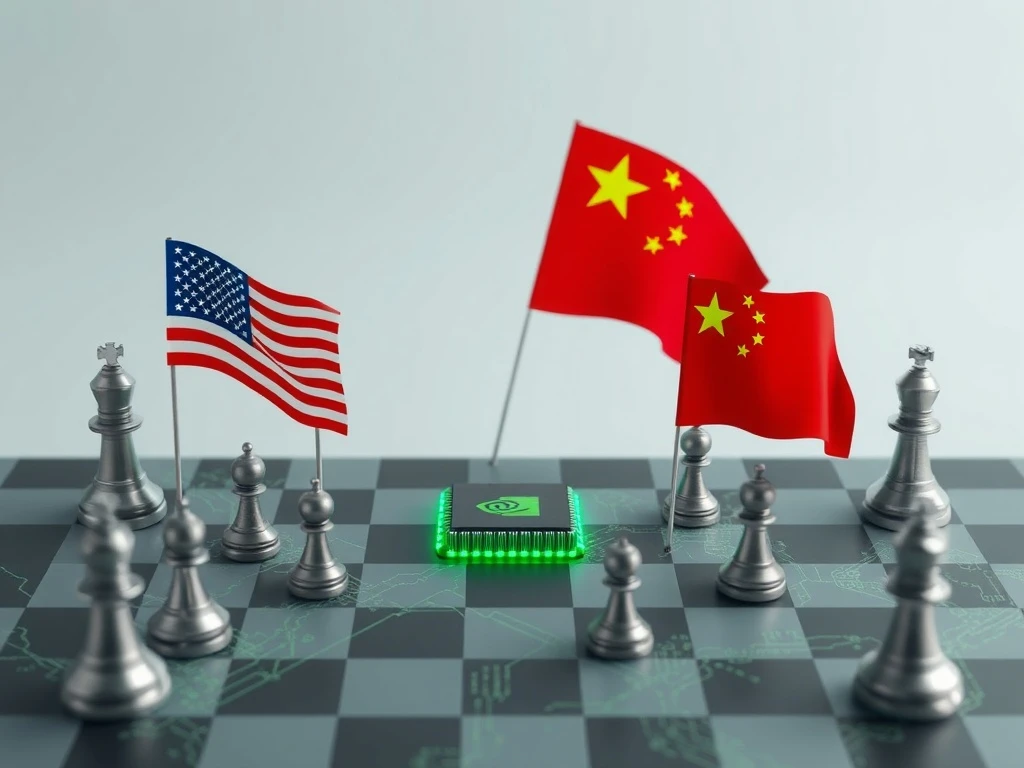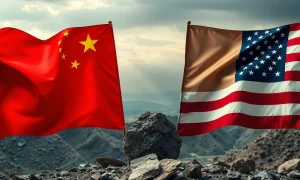The geopolitical landscape often yields unforeseen outcomes. Businesses and entrepreneurs keenly observe global shifts. For instance, former President Trump’s administration aimed to curb China’s artificial intelligence (AI) development. This policy had a specific goal. However, it inadvertently created significant challenges for a prominent American technology company: Nvidia.
Nvidia and the Intensifying US-China Tech Rivalry
The United States and China are engaged in a fierce technological competition. Artificial intelligence stands at its core. Both nations view AI dominance as crucial for economic and military power. Consequently, the Trump administration sought to slow China’s advancements. It targeted key areas, especially access to advanced semiconductors. These chips are essential for AI development. Indeed, they power everything from data centers to advanced algorithms. This rivalry directly impacted companies like Nvidia.
For many years, the global technology supply chain operated with relative openness. Companies like Nvidia thrived by designing chips. They then outsourced manufacturing to facilities worldwide. This model allowed for rapid innovation. It also fostered significant global trade. However, the increasing strategic importance of technology shifted this dynamic. Governments began to prioritize national security over pure economic efficiency. Therefore, new trade barriers emerged quickly.
Trump’s Strategic Moves Against China’s AI Ambitions
The Trump administration implemented several policies. These policies aimed to restrict China’s access to critical technologies. Specifically, they focused on high-end semiconductors. Such chips are vital for advanced AI computing. Key measures included:
- Export Controls: The U.S. government imposed strict controls on technology exports. These controls prevented American companies from selling certain advanced chips to Chinese entities without a license.
- Entity List Designations: Numerous Chinese technology firms, including Huawei, were added to the Commerce Department’s Entity List. This action severely restricted their ability to acquire U.S. technology.
- Supply Chain Disruptions: The administration pressured allies to limit their technology sales to China. This move aimed to create a unified front against China’s tech ambitions.
These actions were designed to hobble China’s progress. They sought to prevent China from developing cutting-edge AI. Ultimately, the goal was to maintain America’s technological lead. However, these policies had broader consequences. They affected global supply chains and major tech players. Companies like Nvidia felt the immediate impact.
The Unintended Consequences for Nvidia’s Market Presence
Nvidia is a global leader in graphics processing units (GPUs). Its GPUs are critical for AI training and deployment. China represents a massive market for Nvidia’s products. Indeed, a significant portion of its revenue comes from this region. When export controls tightened, Nvidia faced a dilemma. It had to comply with U.S. regulations. At the same time, it aimed to retain its market share in China.
Consequently, Nvidia developed specific, less powerful versions of its chips for the Chinese market. These chips met the export control requirements. However, they offered lower performance. This strategy allowed Nvidia to continue selling in China. Yet, it also limited the potential for high-end sales. This directly impacted its revenue streams. Furthermore, it created a challenging competitive environment.
The restrictions also spurred China’s domestic chip industry. Chinese companies began investing heavily in their own research and development. They sought to reduce reliance on foreign technology. This push for self-sufficiency poses a long-term threat to foreign chipmakers. Therefore, Nvidia faces increased competition. Its traditional market dominance in China could erode over time. This makes the landscape for Nvidia more complex.
China’s Accelerated Push for Domestic Chip Innovation
U.S. restrictions had an immediate effect. They galvanized China’s resolve for technological independence. Beijing significantly ramped up investments. It poured resources into its domestic semiconductor industry. The goal was clear: achieve self-sufficiency in critical technologies. This national imperative spurred remarkable growth. Many Chinese companies received substantial government support.
For instance, Semiconductor Manufacturing International Corporation (SMIC) received massive funding. Huawei also diversified its operations. It invested heavily in chip design and manufacturing capabilities. These efforts aimed to bridge the technological gap. They sought to lessen reliance on foreign suppliers. This accelerated pace of innovation directly impacts global market dynamics. It particularly affects companies like Nvidia. They now face a more formidable domestic competitor. This shift fundamentally alters the market landscape.
Long-Term Implications for Nvidia and the Semiconductor Industry
The geopolitical tensions continue to shape the semiconductor industry. For Nvidia, the situation presents both challenges and opportunities. On one hand, restricted access to the full Chinese market limits growth. On the other hand, the global demand for AI chips remains strong. Nvidia continues to innovate. It develops new architectures and software platforms. These efforts help maintain its competitive edge.
However, the broader trend towards technological decoupling is concerning. It could lead to fragmented global standards. It might also increase production costs. Companies like Nvidia must navigate this complex environment. They need to balance global market access with national security concerns. Their ability to adapt will determine their long-term success. Furthermore, the entire semiconductor industry must adjust. It faces increased pressure to diversify supply chains. This ensures resilience against future geopolitical shocks.
Navigating the Future: Nvidia’s Strategic Adaptations
Nvidia actively adapts to the evolving global trade landscape. The company pursues several strategic initiatives. First, it diversifies its customer base. It seeks growth in other regions beyond China. Second, Nvidia invests in new technologies. This includes areas like enterprise AI and metaverse applications. Such investments open new revenue streams. Third, it engages with policymakers. This ensures its voice is heard regarding trade regulations. Ultimately, Nvidia aims to mitigate risks. It seeks to capitalize on emerging opportunities. This proactive approach is crucial for its sustained leadership. It helps Nvidia maintain its position in a dynamic market.
Conclusion: A Complex Web of Geopolitics and Innovation
The Trump administration’s policies aimed to slow China’s AI development. However, they created complex ripple effects. These effects reverberated through the global technology sector. Nvidia, a key player, found itself in an unexpected predicament. While the policies intended to weaken China, they also pushed China towards greater technological independence. This has significant implications for Nvidia’s future. It also impacts the entire semiconductor industry. Ultimately, the story of Nvidia highlights the intricate relationship between geopolitics, trade, and technological progress. Companies must remain agile. They must adapt to ever-changing global dynamics. This ensures their continued success.
Frequently Asked Questions (FAQs)
Q1: What were the primary goals of Trump’s policies concerning China’s AI?
The main goal was to slow China’s development of advanced artificial intelligence. This was achieved by restricting China’s access to critical U.S. technologies, especially high-end semiconductors. The administration aimed to maintain America’s technological superiority and address national security concerns related to China’s growing tech power.
Q2: How did these policies specifically impact Nvidia?
These policies forced Nvidia to comply with export controls. As a result, Nvidia had to create and sell less powerful versions of its AI chips specifically for the Chinese market. This limited its revenue potential from high-end sales in China and potentially opened doors for domestic Chinese competitors.
Q3: Did China’s domestic semiconductor industry benefit from these restrictions?
Yes, indeed. The U.S. restrictions acted as a catalyst for China. Beijing significantly increased investments in its domestic semiconductor industry. This push aimed to achieve self-sufficiency in chip manufacturing and design, reducing reliance on foreign suppliers like Nvidia.
Q4: What is the long-term outlook for Nvidia in the Chinese market?
The long-term outlook for Nvidia in the Chinese market is complex. While China remains a crucial market, increasing domestic competition and ongoing trade restrictions pose significant challenges. Nvidia is adapting by diversifying its global strategy and focusing on innovation to maintain its competitive edge.
Q5: What are the broader implications of these policies for the global tech industry?
These policies contribute to a trend of technological decoupling. This could lead to fragmented global supply chains and standards. It may also increase production costs for technology companies worldwide. The industry faces pressure to diversify and build more resilient supply networks.








